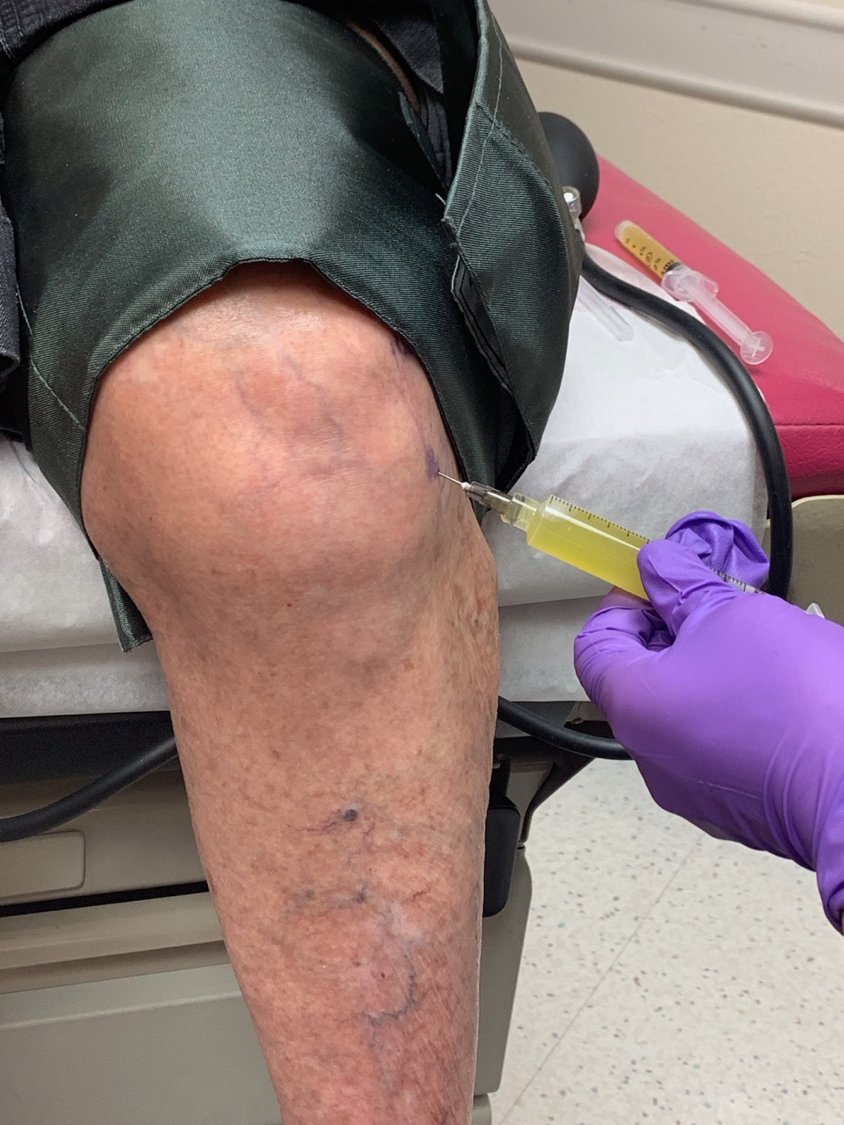Session Information
Session Type: Poster Session (Monday)
Session Time: 9:00AM-11:00AM
Background/Purpose: Arthrocentesis is an essential procedure in diagnosing inflammatory and septic arthritis and is a basic procedure for intra-articular therapy, including therapeutic arthrocentesis and intra-articular injection. Complete arthrocentesis before injection of corticosteroid or hyaluronan confirms the diagnosis, reduces the possibility of superimposed infection, reduces patient pain, and improves response to the injected drug. Meehan et al and others have demonstrated that constant external compression of the knee improves arthrocentesis yield and outcomes. As a quality improvement process, we used a pneumatic compression cuff to apply constant compression to the flexed knee to remove the operator`s hands from potential needlestick, mobilize synovial fluid, and permit more complete arthrocentesis.
Methods: 25 consecutive painful knees (11 OA, 9 OA/RA, 4 RA, 1 RA/septic joint) underwent arthrocentesis performed conventionally and with pneumatic compression. The mean age of the population was 61.3±14.3 years with male:female of 1: 2.1. Pre-procedural pain according to the 10 cm Visual Analogue Pain Scale (VAS) was 8.0±1.2 cm.The quality intervention was designed as a paired study in the same knee: that is, first conventional arthrocentesis in the flexed knee position using the inferolateral approach was performed and quality and outcome measures were obtained. After fluid return ceased, a pneumatic leg cuff, which was placed over the suprapatellar bursa prior to starting the procedure, was inflated to 60 millimeters Hg. Arthrocentesis was then re-attempted, and quality measures were obtained once again.
Results: Procedural pain according to the 10 cm VAS was 3.9±2.8cm and post-procedural pain was 1.0±1.3 cm. In 25 painful knees, conventional arthrocentesis yield was 7.8±18.2 ml and using pneumatic compression was 14.3±27.9 ml, an 84.1% increase (Figure 2). When the 13 effusive knees were analyzed separately, conventional arthrocentesis yield was 18.2±22.7 ml and using pneumatic compression was 27.9±28.6 ml, a 53.3% increase. The mean enhanced arthrocentesis yield reported here with the pneumatic compression in the flexed knee is similar to improved fluid yield that we have reported previously of 16.7±11.3 ml with elastomeric compression of the flexed knee (p = 0.69) and both are similar to the 16.9±15.7 ml arthrocentesis yield that was reported in conventional extended knee arthrocentesis (p = 0.69) (Yaqub et al 2018).
Conclusion: The technique of constant compression using a pneumatic cuff mobilizes residual synovial fluid and improves arthrocentesis success. The use of a pneumatic leg cuff in the flexed knee is a low-cost quality improvement technique that can readily be incorporated into clinical musculoskeletal practice and is particularly useful for performing arthrocentesis in patients in the sitting position, confined to wheelchairs, or with flexion contractures of the knee. Further, since the pneumatic cuff is spatially superior to the inferolateral portal at the puncture site, errant synovial fluid flows down the leg away from the cuff and does not contaminate the device unlike compression devices used in the extended knee positioning.
To cite this abstract in AMA style:
Jafari Farshami F, Trost J, Sibbitt W, Muruganandam M, Band P, Fangtham M, Emil N, Hayward W, Haseler L, Bankhurst A. Quality Improvement in Diagnostic and Therapeutic Arthrocentesis in the Flexed Knee Using Pneumatic Compression of the Suprapatellar Bursa [abstract]. Arthritis Rheumatol. 2019; 71 (suppl 10). https://acrabstracts.org/abstract/quality-improvement-in-diagnostic-and-therapeutic-arthrocentesis-in-the-flexed-knee-using-pneumatic-compression-of-the-suprapatellar-bursa/. Accessed .« Back to 2019 ACR/ARP Annual Meeting
ACR Meeting Abstracts - https://acrabstracts.org/abstract/quality-improvement-in-diagnostic-and-therapeutic-arthrocentesis-in-the-flexed-knee-using-pneumatic-compression-of-the-suprapatellar-bursa/


